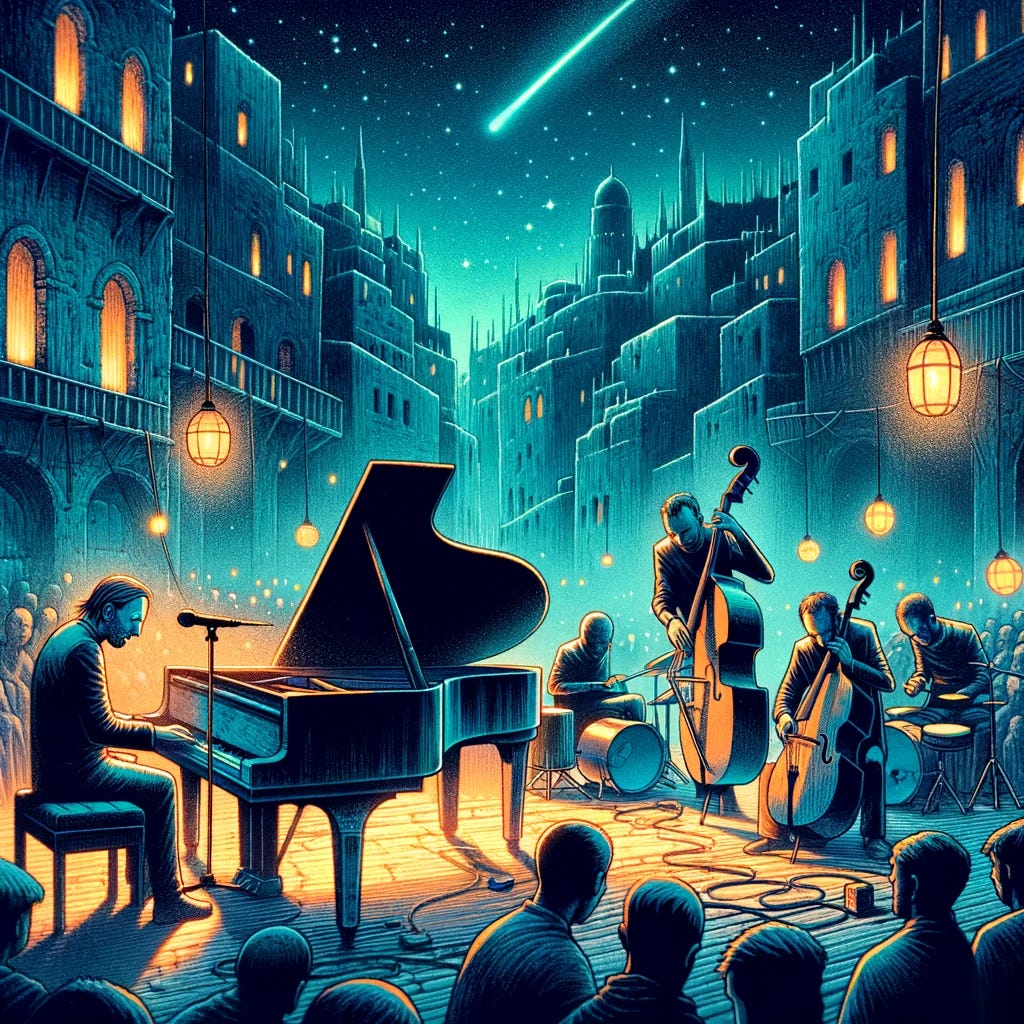It is almost 25 years since I first knowingly read something on Pitchfork. Maybe I had read something before and not realised. There is one review I know I read within days of publication because it was an exceptionally vivid time for me. Much like 16-year-olds in the UK for the previous decades, I was finding my way through new and old music by regularly buying NME, Melody Maker, Select, Uncut and Mojo, and always buying Q magazine. I would hear much of this music, or attempt to, through turn-of-the-century XFM, Evening Sessions and John Peel on BBC Radio 1 later in the evening. I sometimes bought CDs from Amazon at this point. Still, I would mainly go to Our Price, Virgin Megastores and HMV around where I grew up and at the enormous out-of-town shopping mall and access to the music channels in the 440 range on Sky Digital’s remote meant I would regularly dip into MTV|2 as well VH1, The Box and Q’s own channel.
Q TV launched on 2 October 2000, the same day as Drowned In Sound, and Radiohead released their fourth album, Kid A. This was a big deal for me as a nearly 17-year-old Radiohead fan who had already digitised onto my MiniDisc player all of their music I could get my hands on, B-sides and remixes, and the previous albums. As you'd expect, the music press drove this frenzy of anticipation for the new album - Steven Hayden does a good job of covering this in This Is Happening but also online. Fan sites like Green Plastic, Follow Me Around, and, of course, AtEase were able to give fans setlists from the previous night’s gigs, MP3s - which took 30 mins to download - of the new songs and interviews in magazines, scanned and translated for you so you could read what the rest of the world thought of the album1 - there were nay-sayers Melody Maker, Courtney Love and Nick Hornby stick out, but there were rapturous reviews as well. One sticks out and shows how much influence the review had on me. Never mind, the art and industry of reviewing music, as I still recall large parts, is the review by Brent DiCrescenzo.
I’m sure I read other Pitchfork reviews in the years after; there’s no doubt that AtEase would have directed me to Amnesiac, I Might Be Wrong, and Hail To The Thief, at least by the time I was over halfway through university at the start of 2005 I had swapped XFM for BBC 6 Music, Select and Melody Maker had gone with Bang not even making a year there was space and appetite for me to hear, read and learn more. So this is a time when I would be reading and occasionally posting on Sound Opinions Message Board, I Love Music and devouring lists like Pitchfork’s 2003 effort Top 100 Albums of The 1990s in the same way rocklist.net and Acclaimed Music would aid me to continue picking up new, recent and older music.
This was an era where you could get a 100GB external hard drive for around £100 and the likes of Soulseek, You Send It, and Megaupload would allow you not to be left out of the conversation on yesterday’s, today’s and tomorrow’s music. By the end of 2005, it was essential for me not just to have a view on the North American Indie Rock (NAIR) that broke through into the mainstream in the UK or just below it, such as The Killers, Kings of Leon, Arcade Fire and Sufjan Stevens but also the likes of Deerhoof, Animal Collective, Wolf Parade and Clap Your Hands Say Yeah! who were not.
At this point, there were a handful of Pitchfork writers who I knew well enough that come 2006, Scott Plagenhoef sounded me out to write something for the site when they wanted to focus on releases by Transgressive, including a small piece on The Young Knives.
The last few months of 2009 saw several noteworthy developments in the music world that would reverberate for the next decade. In its first full decade of contemporaneously reporting on music, Pitchfork started counting down the collective view of the site’s contributors on the dying embers of the 2000s. Over at a message board, a staff member was slightly put out that as the countdown concluded, many of us could predict the top 20 of both albums and songs. I didn’t, and still don’t today, think this reflected on the list being boring and predictable in any fashion more that the site had established a voice and was setting the cannon2 for the 21st century.
Elsewhere that autumn, the site covered The Beatles' remastered CD catalogue. This was widely perceived as a death knell for the CD, a final hurrah as the world prepared to move through the MP3 era into the streaming era we now reside in. In 1987, the music industry shifted from vinyl and cassette tapes to CDs, and the release of The Beatles' catalogue in the new digital format gave consumers a compelling reason to adopt it. The 2009 re-releases were accompanied by a significant remastering effort, which suggests that they were intended to be definitive versions—perhaps a final physical release before the complete transition to digital formats. This gesture could be interpreted as a tacit acknowledgement that the era of physical media dominance was ending.
From 2017 onwards, we have the physical output as a luxury product - I can’t imagine that many people who have bought Sgt Pepper, The White Album, Abbey Road, Let It Be, Revolver, and the Red and Blue albums didn’t already have a copy of them on CD at least. That’s because, in 2009, Spotify started to launch in countries outside of Scandinavia, and the seeds had been sown to move away from the physical format almost entirely away from hobbyists.
The sale of Pitchfork Media to Condé Nast in late 2015 elicited diverse reactions within the music community. Some viewed the acquisition as a significant shift for the independent music site, now under the umbrella of a large media conglomerate known for publications like The New Yorker and Teen Vogue. This transition raised questions about Pitchfork's future direction, particularly its editorial independence and the potential impact on its content and ethos.
Many would note the site's evolution from a niche music review at the turn of the century to a more commercially oriented entity, with increasing reliance on advertising, festival sponsorships, and partnerships. The sale to Condé Nast culminated in this shift, leading to apprehensions about further commercialisation and loss of the site's original spirit. There was also a sense of irony in Pitchfork, once a champion of indie music, joining a mainstream media giant.
By this point, I was among the people who were happy to see people who’d given so much to them financially benefit from the sale. I was still listening to new music, maybe not as much as in 2005, but the passion was there. I felt no need to have an opinion on everything the site gave a BNM to, and I suspect I wasn’t the only one after years of trying to keep up.
As we get closer to the present day, it is worth looking at the differences between Pitchfork in the 2000s and what it was as the 2020s approached. The site was viewed by the very people who bought it in 2015 as they acquired it as an opportunity to bring;
…a very passionate audience of Millennial males into our roster
That’s Conde Nast’s Chief Digital Officer Fred Santarpia with a statement that quickly drew backlash. Despite Pitchfork's efforts to diversify its content and address broader topics like gender and race, Santarpia's comment suggests focusing on a specific demographic segment. With 88% of Pitchfork's poll respondents in 2012 being male and men comprising a significant portion of the site's traffic (57% by some accounts), the site has made great strides to cover a much more comprehensive brief than the narrow genre that made its name.
Pitchfork broadened its coverage to include more mainstream pop music over the last few years. This pivot reflected a recognition of the evolving musical landscape and the growing influence of pop. Not only this, the site also pushed out in other directions to address representation issues, with an increasing emphasis on music created by women, members of the queer community, and artists from the global south. For anyone who hadn’t noticed this, the now annual September list mania has seen a rebalancing, with 12 female artists in their 2022 top 20 albums of the 1990s compared to four in the reader’s poll (and one in the 2003 poll.). Some people found this odd, but I think it reflected where the cannon has moved over the last twenty years, with voices not being heard, including those who don’t like and are missing items through their youth or not being in the tent. I think many changes between the two lists are positive, but as it is not my list, I still see things I don’t like and missing items I like, as in the readers and the 2003 lists.
Finally, we get to present with the news that inspired this article that Pitchfork is being folded into GQ. I’ve not got anything like the history with the site that many others have, and I would direct you to these for better-informed takes;
Ezra Klein in The New York Times
Spencer Kornhaber in The Atlantic
And no doubt many more.
There are questions about who and where new bands break, and I get that most people are pretty bummed out by this news, and I am as well. When Pitchfork made inroads, it took advantage of the fact that in the US, because of the size and the concentration of many music scenes and genres in the country pre-internet, the cycle was more monthly. In the UK, everything was more concentrated, allowing NME and Melody Maker to flourish for several decades. Someone or something will fill the gap - maybe even subscriber letters like this one.
With apologies to the Pitchfork feature 5-10-15-20.
I now realise that all this was going on for most of the preceding decade in various iterations on Usenet forums and communities. Still, given that I was in the UK without dial-up access until 1998/9 and was 11 years old for most of 1995, it had passed me by.
If you don’t buy this argument, look at their Sep-2009 list and compare it to the Acclaimed Music update from 2020 - 11 of the albums and 9 of the songs are shared with a decade’s hindsight.













